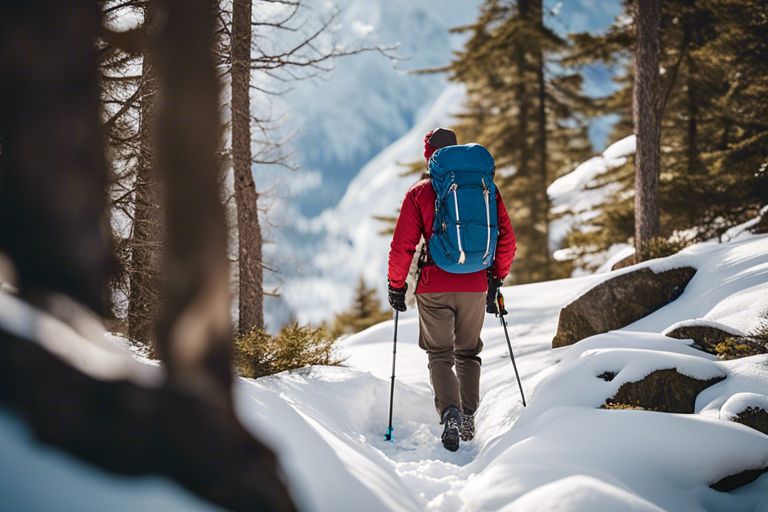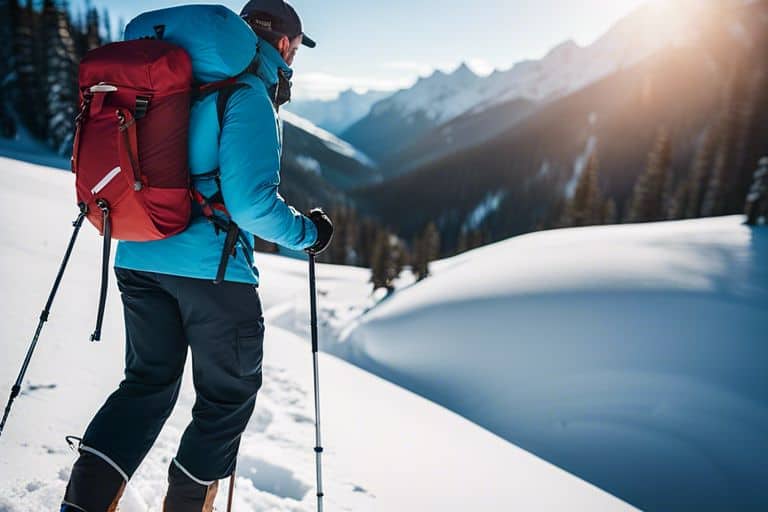Are you ready to embark on a winter hiking adventure? While the snowy landscapes and crisp, cold air can make for a breathtaking experience, it’s crucial to prioritize your safety first. The frigid temperatures and harsh conditions of winter hiking can pose serious risks to your well-being, from frostbite and hypothermia to slippery trails and limited daylight. By taking the necessary precautions and properly preparing for your excursion, you can minimize the chances of cold-related injuries and ensure a safe and enjoyable outdoor experience. In this blog post, we’ll cover essential tips and guidelines for winter hiking safety to help you stay warm, protected, and prepared during your cold-weather adventures. Remember, your safety should always be your top priority when exploring the great outdoors in winter.
Key Takeaways:
- Layer up: Dress in layers to maintain body heat, including moisture-wicking base layers, insulating mid-layers, and windproof and waterproof outer layers.
- Keep moving: Continuous movement can help stave off hypothermia and frostbite, so keep the blood flowing through regular exercise and stretching breaks.
- Stay hydrated and fueled: Drink plenty of water and eat high-energy snacks to maintain body temperature and prevent dehydration.
- Be prepared: Always carry a map, compass, and a fully charged cell phone for navigation and communication in case of an emergency.
- Know the signs: Educate yourself on the symptoms of cold-related injuries, such as hypothermia and frostbite, and be ready to seek shelter and medical attention if necessary.

Essential Equipment for Winter Hiking
By ensuring you have the right equipment, you can greatly reduce the risk of cold-related injuries when out on a winter hike. There are a few key pieces of gear that are essential for keeping you safe and comfortable in cold and potentially hazardous conditions.
Selecting Proper Gear for Cold Weather
When it comes to gearing up for winter hiking, layering is essential. You need a good base layer that wicks moisture away from your skin, a warm mid-layer for insulation, and an outer layer that provides protection from wind and moisture. Make sure that your clothing is breathable to prevent overheating and sweating, which can lead to dampness and ultimately, chill. So, when selecting your gear, opt for fabrics like merino wool or synthetic materials that will keep you warm and dry.
Innovative Technologies in Winter Hiking Apparel
Advancements in technology have led to the development of innovative fabrics and materials that are specifically designed for winter hiking. Look for gear that incorporates moisture-wicking properties to keep you dry, insulation to keep you warm, and waterproofing to protect you from the elements. Additionally, certain brands now offer heated clothing options, such as heated socks and gloves, which can be invaluable in extreme cold conditions. These technologies can make a significant difference in keeping you comfortable and safe during your winter hikes.
Preparing for the Trail
Despite the beautiful winter scenery, it’s important to remember that hiking in the winter comes with its own set of challenges and risks. Before hitting the trail, it’s crucial to properly prepare and plan for the winter conditions to ensure a safe and enjoyable hiking experience. Here are some key considerations to keep in mind when preparing for winter hiking:
Technique and Training for Winter Conditions
First and foremost, it’s essential to have the right techniques and training for winter hiking. This includes familiarizing yourself with proper layering techniques to stay warm and dry, as well as learning how to navigate through snow and ice. It’s recommended to practice these skills in a controlled environment before heading out on a winter hiking trip. Additionally, consider taking a winter hiking course or joining a guided hike to learn from experienced professionals. Being properly trained and prepared for the winter conditions will significantly reduce the risk of cold-related injuries and ensure a safer outdoor adventure.
Strategy and Tactics for Winter Hiking
When it comes to winter hiking, having a solid strategy and tactics in place can make all the difference in your safety and enjoyment. This includes planning your route carefully, considering the weather and trail conditions, and setting realistic expectations for your hiking pace. It’s crucial to know your limits and be prepared to adjust your plans based on the conditions you encounter. Additionally, always make sure to inform someone of your hiking itinerary and expected return time. Packing essential items such as a map, compass, and emergency supplies is also crucial for staying safe in winter conditions. By employing the right strategies and tactics, you can minimize the risks associated with winter hiking and make the most of your outdoor adventure.
Winter Hiking Safety – Prevent Cold-Related Injuries
Now let’s talk about navigating through weather variations when hiking in winter. The weather can be unpredictable and change rapidly, so it’s important to be prepared for any conditions you might encounter.
Understanding and Preparing for Weather Changes
When you’re out hiking in the winter, you need to be ready for sudden changes in weather. Keep an eye on the forecast before you set out, but also be prepared for the unexpected. Pack layers of clothing that you can easily add or remove as the temperature fluctuates. Bring waterproof and windproof outer layers to protect you from rain, snow, and high winds. Additionally, make sure you have extra food, water, and a shelter in case you get caught in a storm.
Techniques for Weathering the Cold
When hiking in cold weather, it’s important to know how to stay warm and dry. Layering your clothing is essential for trapping body heat and wicking away moisture. Start with a moisture-wicking base layer, add an insulating layer for warmth, and finish with a waterproof and windproof outer layer. Keep your extremities warm by wearing insulated gloves, thick socks, and a hat. If you start to sweat, remove a layer of clothing to prevent moisture from building up. And remember to keep moving to generate body heat, but take breaks when necessary to prevent overheating and sweating excessively.
| Understanding and Preparing for Weather Changes | Techniques for Weathering the Cold |
| 1. Check the forecast and be prepared for sudden changes. | 1. Layer your clothing to trap body heat and wick away moisture. |
| 2. Pack extra clothing, food, water, and a shelter in case of a storm. | 2. Keep extremities warm with insulated gloves, thick socks, and a hat. |
| 3. Bring waterproof and windproof outer layers to protect from the elements. | 3. Remove a layer of clothing if you start to sweat, and take breaks when needed. |
Nutrition and Hydration in Cold Weather
Your nutrition and hydration needs are slightly different in cold weather compared to other seasons. In order to stay safe and enjoy your winter hike, it’s important to understand the role of nutrition and hydration in cold weather conditions.
The Role of Nutrition in Maintaining Energy Levels
Proper nutrition is essential for maintaining energy levels during winter hiking. In cold weather, your body works harder to stay warm, which means you burn more calories than usual. You need to fuel your body with the right foods to sustain energy levels and prevent fatigue. High carbohydrate snacks like trail mix, energy bars, and dried fruit are great options to keep your energy levels up during your hike.
Staying Hydrated in Sub-Zero Temperatures
Staying hydrated is just as essential in cold weather as it is in warm weather, if not more so. Cold weather can trick you into thinking you’re not as thirsty as you really are, so you may not feel compelled to drink as much. However, in cold, dry conditions, your body loses moisture through respiration and sweat evaporation, causing dehydration to occur more quickly than you realize.
| Dangerous | Positive |
| Dehydration can lead to hypothermia and frostbite in sub-zero temperatures. | Staying properly hydrated can help keep your body functioning optimally and maintain circulation to your extremities. |
Safety Protocols and Emergency Procedures
Lastly, it is crucial to be prepared with safety protocols and emergency procedures to ensure that you can handle any unexpected situations that may arise during your winter hiking adventures. These protocols can help prevent and minimize the risk of cold-related injuries and ensure prompt action in case of an emergency. Here are some essential safety measures to consider:
Defensive Measures Against Cold-Related Injuries
When venturing out into the cold, it’s imperative to take defensive measures to protect yourself from the risk of cold-related injuries. This includes wearing appropriate clothing and gear such as insulated, moisture-wicking layers, waterproof boots, gloves, and a hat to keep your body warm and dry. Additionally, carry essential items such as a first-aid kit, emergency blankets, and a portable stove for warmth in case of an emergency. Being prepared with the right gear and tools can make all the difference in preventing cold-related injuries.
Professional Guidance and Training
Seeking professional guidance and training can provide you with invaluable knowledge and skills to navigate winter hiking safely. Consider taking a wilderness first aid course to learn how to recognize and treat cold-related injuries, as well as other common outdoor emergencies. Additionally, hiring a certified guide for your winter hikes can provide you with expert advice on route planning, safety protocols, and emergency procedures. By gaining the necessary training and guidance, you can enhance your preparedness and confidence in handling potential cold-related emergencies.
Risk Management and Accident Prevention
To ensure your safety while winter hiking, it’s crucial to have a solid understanding of risk management and accident prevention. By being proactive and prepared, you can greatly reduce the likelihood of encountering dangerous situations while on the trails. Whether you’re an experienced hiker or a beginner, following safety protocols is essential for a successful and enjoyable cold-weather adventure.
Offense Against Potential Hazards
When heading out for a winter hike, it’s important to recognize and prepare for potential hazards. One of the most significant dangers you’ll face is the risk of hypothermia. This occurs when your body loses heat faster than it can produce it, causing a dangerously low body temperature. To combat this, it’s essential to dress in insulating layers and ensure your clothing remains dry. Additionally, familiarize yourself with the signs and symptoms of hypothermia, and know what to do in the event that you or a fellow hiker exhibits them. Another hazard to be aware of is slippery terrain, which can lead to falls and injuries. Investing in a pair of traction devices for your shoes can provide essential grip on icy surfaces, reducing the risk of accidents. By being proactive and prepared, you can greatly reduce the likelihood of encountering dangerous situations while on the trails.
Tools for Emergency Situations
Properly equipping yourself with the essential tools for emergency situations is crucial for a safe winter hiking experience. This includes carrying a first aid kit with supplies tailored to cold-weather injuries, such as frostbite and hypothermia. Additionally, having a navigation device and knowing how to use it is essential for finding your way in challenging winter conditions. Alongside this, ensuring you have adequate communication devices, such as a fully charged cell phone or a GPS locator beacon, is imperative in the event of an emergency. By having these tools readily available, you can feel more confident and secure during your winter hiking adventures.
Psychological Considerations and Group Dynamics
After preparing yourself physically and gathering the right gear, it’s important to consider the psychological and group dynamic aspects of winter hiking. According to Harvard Health Publishing, creating a positive mental approach is key to enjoying winter hiking and staying safe. Winter hiking can be magical or miserable, depending on your mindset and group dynamics.
The Psychological Impact of Winter Hiking
Winter hiking can have a significant psychological impact on you. The combination of cold temperatures, shorter daylight hours, and challenging terrain can be mentally taxing. It’s important to prepare yourself for these challenges and develop a positive mindset. Embracing the unique beauty of the winter landscape and the sense of accomplishment from conquering the elements can be incredibly rewarding. However, it’s essential to be aware of the potential psychological stress and have strategies in place to cope with it.
Team Formation and Leadership in Hiking Groups
When hiking in winter conditions, the dynamics of your hiking group play a crucial role in your overall experience and safety. The formation of a cohesive team and effective leadership are essential in ensuring a successful excursion. It’s important to have a designated leader who can make sound decisions and guide the group through challenging situations. Additionally, forming strong bonds with your hiking companions can provide crucial support and camaraderie during the hike. Communication and mutual respect within the group are vital for a safe and enjoyable winter hiking experience.
Winter Hiking Safety – Prevent Cold-Related Injuries
Hence, it is crucial to be prepared and knowledgeable about winter hiking safety in order to prevent cold-related injuries. By following the tips and guidelines outlined in this article, you can ensure that you have a safe and enjoyable winter hiking experience. Remember to dress in layers, stay hydrated, and be aware of the signs of cold-related injuries such as frostbite and hypothermia. By being proactive and taking the necessary precautions, you can minimize the risk of cold-related injuries and make the most of your winter hiking adventures.
Winter Hiking Safety – Prevent Cold-Related Injuries
Q: What gear should I bring for a winter hike to prevent cold-related injuries?
A: When hiking in the winter, it is crucial to dress in layers and bring the appropriate gear. This includes thermal underwear, moisture-wicking base layers, insulating layers, waterproof and windproof outer layers, warm gloves, hats, and scarves, sturdy insulated boots, and snowshoes or crampons if necessary. Additionally, it is essential to pack plenty of high-energy snacks, a hot drink, a map and compass, a first aid kit, and a fully charged cell phone for emergencies.
Q: How can I prevent frostbite and hypothermia while hiking in the winter?
A: To prevent frostbite and hypothermia, it is essential to keep your body warm and dry. This can be achieved by wearing proper clothing, staying hydrated and well-fed, and taking frequent breaks to warm up. Avoiding cotton clothing, which retains moisture, and keeping an eye on weather forecasts are also crucial. It is important to recognize the early signs of frostbite and hypothermia – such as numbness, tingling, pale or white skin, uncontrollable shivering, slurred speech, and poor coordination – and take immediate action if symptoms occur.
Q: What should I do if I or someone in my hiking group becomes injured or stranded during a winter hike?
A: If you or someone in your hiking group becomes injured or stranded during a winter hike, it is crucial to stay calm and assess the situation. If possible, find or create shelter, start a fire for warmth and signaling, and use any available supplies to insulate the injured or stranded individual from the cold ground. It is also important to have a plan in place before heading out, including leaving a detailed itinerary with someone reliable and having a clear understanding of the route and terrain. In the event of an emergency, contact emergency services as soon as possible and follow their instructions while awaiting rescue.



0 Comments